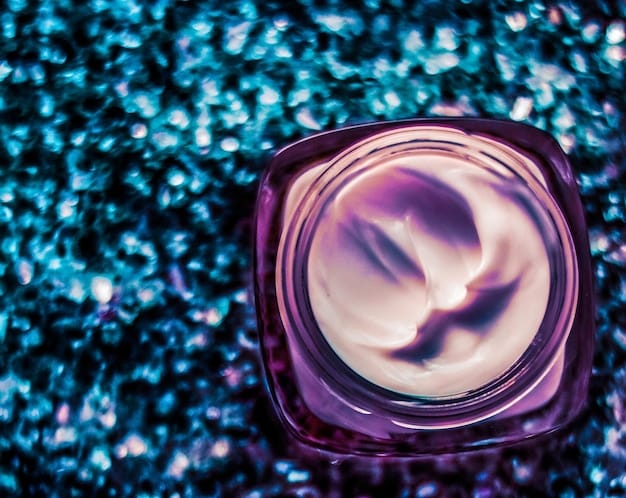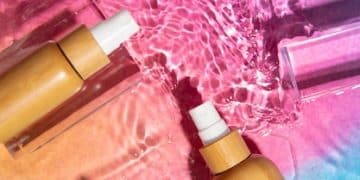How K-Beauty Will Dominate the US Cosmetics Market by 2025

Korean beauty products are poised to significantly reshape the US cosmetics market by 2025, driven by innovative formulations, unique ingredients, and a focus on skincare as self-care, appealing to a broad demographic seeking effective and personalized beauty solutions.
Get ready for a skincare revolution! How Korean beauty products are changing the US cosmetics market in 2025 is a trend you can’t ignore. From innovative ingredients to personalized routines, K-beauty is set to redefine how Americans approach skincare and makeup.
The Rise of K-Beauty in the US Market
Korean beauty, or K-beauty, has steadily gained popularity in the United States over the past decade. Its appeal lies in its innovative formulations, focus on natural ingredients, and emphasis on achieving healthy, glowing skin. This approach differs from traditional Western beauty standards, which often prioritize quick fixes and heavy makeup.
As we look ahead to 2025, several factors indicate that K-beauty’s influence will only continue to grow in the US cosmetics market. These include increasing consumer demand, the expansion of K-beauty brands into mainstream retail channels, and the ongoing influence of social media and K-dramas in shaping beauty trends.
The Philosophy Behind K-Beauty
K-beauty is more than just skincare; it’s a holistic approach to beauty that emphasizes prevention and overall skin health. Unlike Western skincare routines that often focus on treating specific problems after they arise, K-beauty encourages a proactive approach to maintaining skin health. This includes practices like double cleansing, regular exfoliation, and the use of hydrating and nourishing ingredients.
Furthermore, K-beauty routines tend to be highly personalized, with consumers encouraged to tailor their skincare regimen to their individual skin types and concerns. This emphasis on customization and self-care has resonated with American consumers, who are increasingly seeking out products and routines that cater to their specific needs.
- Focus on Prevention: K-beauty prioritizes maintaining skin health to prevent problems from occurring.
- Natural Ingredients: Many K-beauty products incorporate natural and gentle ingredients.
- Personalized Routines: Tailoring skincare to individual skin types is a key principle.
- Holistic Approach: K-beauty views skincare as part of overall well-being.
In conclusion, K-beauty’s focus on prevention, natural ingredients, personalized routines, and a holistic approach to beauty has laid a strong foundation for its continued growth in the US market.
Key Trends Driving K-Beauty’s Growth in 2025
Several trends indicate that K-beauty is poised for even greater success in the US market by 2025. These trends range from technological advancements in product development to the growing influence of social media and cultural trends.
Understanding these key trends can provide valuable insights into the future of the US cosmetics market and the role that K-beauty will play in shaping it.

Innovation and Technology
K-beauty is known for its innovative formulations and use of cutting-edge technology. From unique ingredients like snail mucin and bee venom to advanced delivery systems like micro-needling patches, K-beauty brands are constantly pushing the boundaries of skincare innovation.
In 2025, we can expect to see even more technological advancements in K-beauty product development, including the use of artificial intelligence (AI) to personalize skincare routines and the incorporation of biotechnology to create even more effective and targeted treatments.
Social Media Influence
Social media platforms like Instagram, TikTok, and YouTube have played a significant role in popularizing K-beauty around the world. Beauty influencers and content creators regularly share their favorite K-beauty products and routines, exposing their followers to new brands and trends.
By 2025, social media is likely to play an even more important role in shaping beauty trends and driving K-beauty’s growth. Brands that can effectively leverage social media to connect with consumers and build brand awareness will be well-positioned for success.
- AI-Powered Personalization: Skincare routines tailored by artificial intelligence.
- Biotechnology Integration: Advanced treatments using cutting-edge biotechnology.
- Influencer Marketing: Social media influencers driving brand awareness and sales.
- Trendsetting Content: Social media platforms shaping beauty trends globally.
In summary, the combination of innovation, technology, and social media influence is expected to propel K-beauty’s growth in the US market by 2025, providing consumers with more personalized, effective, and technologically advanced skincare options.
The Impact of K-Dramas on Beauty Trends
K-dramas have become a global phenomenon, captivating audiences with their compelling storylines, talented actors, and impeccable production values. Beyond entertainment, K-dramas have also had a significant impact on beauty trends, particularly in the US market.
The flawless skin and stylish looks of K-drama actors and actresses have inspired viewers to adopt K-beauty routines and try new products. This influence is expected to continue to grow in 2025, as K-dramas become even more accessible through streaming services and online platforms.
The “Glass Skin” Effect
One of the most prominent beauty trends to emerge from K-dramas is the concept of “glass skin,” which refers to a complexion that is so clear, smooth, and radiant that it resembles glass. Achieving glass skin requires a multi-step skincare routine that focuses on hydration, exfoliation, and protection from the sun.
K-beauty products are particularly well-suited for achieving the glass skin look, as they often contain hydrating and brightening ingredients like hyaluronic acid, vitamin C, and niacinamide. As more Americans aspire to achieve the glass skin look, demand for K-beauty products is likely to increase.
Celebrity Endorsements
Many K-beauty brands partner with K-drama actors and actresses to promote their products. These celebrity endorsements can be incredibly effective in driving sales and building brand awareness.
By 2025, we can expect to see even more K-beauty brands partnering with celebrities to reach American consumers. These partnerships will help to further solidify K-beauty’s position in the US cosmetics market.
- Flawless Complexions: K-drama actors inspiring “glass skin” aspirations.
- Hydration Focus: Products with hyaluronic acid, vitamin C, and niacinamide gaining popularity.
- Brand Partnerships: Celebrity endorsements driving sales and recognition.
- Increased Accessibility: Streaming services enhancing K-drama viewership and influence.
To conclude, the influence of K-dramas on beauty trends, particularly the pursuit of “glass skin” and celebrity endorsements, is set to intensify in the US market by 2025, further boosting the demand for K-beauty products influenced by popular K-drama shows.
Adapting to the American Consumer
While K-beauty has gained significant traction in the US market, K-beauty brands must adapt their products and marketing strategies to appeal to American consumers.
This includes understanding the unique needs and preferences of different demographic groups and tailoring products and messaging accordingly.

Customization and Personalization
American consumers are increasingly seeking out personalized products and experiences. K-beauty brands can cater to this demand by offering customizable skincare routines and products that are tailored to specific skin types and concerns.
This could include offering online quizzes or consultations to help consumers determine their skin type and recommending products accordingly. Brands could also offer customizable skincare sets or allow consumers to mix and match products to create their own unique routines.
Ingredient Transparency
American consumers are becoming more aware of the ingredients in their skincare products and are increasingly demanding transparency from brands. K-beauty brands can build trust with American consumers by clearly labeling their products with a full list of ingredients and providing information about the purpose and benefits of each ingredient.
Brands can also consider using natural and organic ingredients, which are increasingly popular among American consumers.
- Personalized Recommendations: Offering quizzes to tailor skincare products to individual needs.
- Customizable Sets: Allowing consumers to create their own unique skincare routines.
- Clear Labeling: Providing full ingredient lists for transparency.
- Natural and Organic Options: Catering to the growing demand for eco-friendly ingredients.
In conclusion, K-beauty brands that focus on customization, personalization, ingredient transparency, and natural/organic options will be best positioned to capture the attention and loyalty of American consumers, ensuring continued growth in the US market by 2025.
The Role of E-Commerce and Retail Partnerships
E-commerce has played a crucial role in K-beauty’s success in the US market. Online retailers like Amazon, Sephora, and Ulta Beauty have made it easier for American consumers to access K-beauty products from the comfort of their own homes.
In 2025, e-commerce is likely to remain an important channel for K-beauty brands, but we can also expect to see more brands forming partnerships with brick-and-mortar retailers to expand their reach and visibility.
Strategic Retail Partnerships
Partnering with established retailers like Target and Walmart can help K-beauty brands reach a wider audience and increase brand awareness. These partnerships can also provide K-beauty brands with valuable shelf space and marketing support.
Brands can also consider opening their own standalone stores in major cities. This can help to create a more immersive and engaging brand experience for consumers.
Subscription Services
Subscription services like Birchbox and Ipsy have also played a role in introducing American consumers to K-beauty products. These services allow consumers to sample a variety of K-beauty products each month for a set price.
By 2025, subscription services are likely to remain a popular way for consumers to discover new K-beauty products and brands.
- Expanded Reach: Strategic partnerships with major retailers increasing brand access.
- Immersive Experiences: Standalone stores offering engaging consumer experiences.
- Product Discovery: Subscription services providing opportunities to sample new items.
- E-Commerce Dominance: Online retail continuing as a crucial sales channel.
Consequently, strategic retail partnerships, continued e-commerce dominance, and the convenience of subscription services will collectively support the growth and accessibility of K-beauty in the US market by 2025.
Challenges and Opportunities for K-Beauty Brands
While K-beauty has a bright future in the US market, K-beauty brands also face several challenges. Addressing these challenges and capitalizing on emerging opportunities will be crucial for long-term success.
These challenges include increased competition, evolving consumer preferences, and the need to maintain brand authenticity.
Increased Competition
As K-beauty becomes more popular, more brands are entering the market. This increased competition can make it difficult for brands to stand out and attract consumers.
K-beauty brands can differentiate themselves by focusing on innovation, quality, and customer service. They can also consider targeting niche markets or developing unique value propositions.
Maintaining Brand Authenticity
American consumers value authenticity. K-beauty brands must ensure that their products and messaging are true to their Korean roots.
This means preserving the unique cultural elements of K-beauty and avoiding the temptation to simply copy Western beauty trends.
- Differentiation Strategies: K-beauty brands focus on innovation, quality and customer service.
- Niche Market Targeting: Brands cater to niche markets through unique value propositions.
- Cultural Integrity: Preserving the unique heritage of K-beauty.
- Evolving Preferences: Adapting to changing consumer needs for sustained success.
Ultimately, addressing challenges through differentiation and innovation, whilst maintaining brand authenticity by staying true to their unique heritage, will enable K-beauty brands to thrive in the US market by 2025.
| Key Point | Brief Description |
|---|---|
| 🧪 Innovation & Tech | AI for personalized care and advanced biotech treatments. |
| 🎬 K-Drama Influence | “Glass skin” and celebrity endorsements drive product demand. |
| 🛍️ E-Commerce & Retail | Partnerships expand reach; subscriptions aid discovery. |
| 🌱 Adapting to US | Personalization, transparency, and natural ingredients appeal. |
FAQ
▼
K-beauty stands out with its focus on gentle, natural ingredients, emphasis on multi-step skincare routines, and the integration of advanced technology for personalized and effective skincare solutions.
▼
K-dramas showcase actors and actresses with flawless skin, inspiring viewers to adopt K-beauty routines and products to achieve a similar “glass skin” complexion.
▼
E-commerce platforms have made K-beauty products easily accessible to a broad audience, allowing consumers to discover, purchase, and integrate these products into their daily skincare routines.
▼
K-beauty brands can attract American consumers by offering customizable products, ensuring ingredient transparency, using natural and organic ingredients, and providing effective customer service.
▼
The main challenges include increased competition, maintaining brand authenticity, and adapting to the evolving preferences and demands of the American consumer base to ensure sustained growth.
Conclusion
In conclusion, Korean beauty products are set to revolutionize the US cosmetics market by 2025, driven by innovative formulations, social media influence, the impact of K-dramas, and strategic e-commerce partnerships. While challenges like increased competition and maintaining brand authenticity exist, brands that focus on customization, transparency, and quality will thrive, further solidifying K-beauty’s prominent role in the American beauty landscape.





